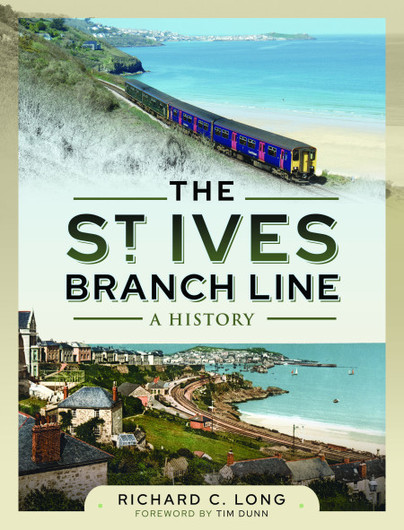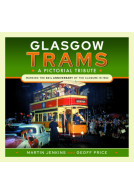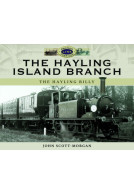The St Ives Branch Line: A History (Hardback)
Imprint: Pen & Sword Transport
Pages: 184
Illustrations: 90 colour & black and white illustrations
ISBN: 9781399002004
Published: 28th July 2022
(click here for international delivery rates)
Need a currency converter? Check XE.com for live rates
| Other formats available - Buy the Hardback and get the eBook for £1.99! | Price |
|---|---|
| The St Ives Branch Line: A History eBook (23.8 MB) Add to Basket | £15.59 |
In 1963 comic duo Flanders and Swann composed Slow Train - a lament for some of the many railway lines proposed for closure by Dr Beeching. Among the destinations listed in their song is the refrain “from St Erth to St Ives”. Constructed in 1877 as the last broad gauge line to be built in the UK, the St Ives branch did not close in the 1960s and survives to this day – now widely regarded as one of the most scenic railways in Europe. How did it escape closure, and how did it come to be built in the first place?
Why did the war departments of the world have their eyes on St Ives in the years before the First World War? How did a town once renowned for the inescapable smell of fish become one of the most popular tourist resorts in the UK? Did the Great Western Railway invent the Cornish Riviera? Why was a heliport proposed for St Erth? Where did a 32-ton ballast digger end-up in 2008? And how did two young men find themselves four miles from the nearest station in 1860…?
Containing over 100 images, mostly in colour and many never published before, this book sets out to answer these and many more questions.
As featured in
The Great Western Echo - Journal of the Great Western Society
Rating: 5 out of 5 stars
NetGalley, jane brown
I am fascinated by railways and the Beeching cuts of the sixties and as a child was lucky to go on a steam train from Waverly to Fife in thr late sixties.
The cover to start with is worth a mention and would encourage readers to pick this interesting book up.
Steeped in history -Richard Long's book takes us on a journey through the late Victorian age into the 20th century and to date with all the history and uncertainty as well as achievements documented in this book. If you want photos and data it is all there - well researched - a great account of social history.
Your reviewer’s childhood summer holiday fortnight was always spent at Penzance (travelling by train, of course), and this always included several happy trips to the beaches at Carbis Bay & St Ives. So of course, this is a subject close to my heart, and it appears to be the same for many others, whether railway enthusiasts or not, as the branch is often described as one of the best of British lines.
Bradford Railway Circle "The Circular"
The book covers the entire history of the line: Chapter 1 deals with early proposals, which began as long ago as 1844, though construction (Chap.2) did not start until 1874. The route is described in Chap.3, from St. Erth (MP 321 from Paddington is on the platform) via the sand-dunes of Lelant and the bracken-covered cliffs of Carbis Bay to the town of St. Ives. Chapter 4 covers the early years, from opening in 1877 until the first world war. The next chapter describes how tourism quickly became a major source of traffic - day-trips from Penzance and its surrounds; golfing and other holidays, especially the GWR’s Tregenna Castle Hotel overlooking St. Ives; and the effect of the artist colony that grew up in and around the town. The “Cornish Riviera Express” and its relief had up to seven through carriages from Paddington to St Ives for a number of years. But as Chapter 6, “The Beeching Era”, describes, in 1961 the little 45xx 2-6-2T’s on the branch were replaced by dmu’s, and as tourism became more car-oriented, traffic declined and closure rumours grew. There was a lot of local opposition, as the branch really was the town’s lifeline, and there was a temporary reprieve in 1964. But BT announced proposed closure in 1965, leading to a TUCC inquiry in 1966. However, Labour’s Barbara Castle reprieved the line, along with many others, and Chap.7 (“1970’s – the Age of the Car”) shows how, although much of the station architecture was lost in rationalization schemes, efforts began to improve facilities by encouraging car-users to use the line, culminating in the highly successful 1978 Park-and-Ride station at Lelant. Chapter 8 deals with the use of class 142 Skippers, class 122 “bubble-cars”/“heritage units”, class 153 Sprinters and other types in the 1980’s and 1990’s – the variety of classes tried out reflected the range of different problems that arose, from tight curves on the line to the age of the units. Lastly, Chapter 9 “The Privatisation Era” brings us up to date with all the latest developments, which have contributed to an amazing turnaround in the fortunes of the branch. There is an Appendix which shows how passenger numbers have grown from 291,000 in 2001 to over 650,000 in 2019. There is also a very good Bibliography, a Notes section (references to newspaper and magazine articles), and an Index.
This is a very comprehensive work, carefully researched and very well written. The quality of printing and production is excellent, as always from Pen & Sword. The illustrations are well-chosen, covering all stages in the line’s life. All in all, an excellent book, likely to be of interest not only to GW and branch-line enthusiasts, but also many others who have fond memories of the line.
As featured by
The Broad Gauge Society
"The railway today has become a major tourist line boasting a record 662,374 passengers in 2019, cementing its future after its tricky start and a reprieve from closure in 1966. If you have not travelled on this line already this book will encourage a trip in the near future."
Swanage Railway Magazine – Winter 2023, Issue 129
Built in 1887, as the last broad gauge line, the St Ives branch in Cornwall was originally slated for closure under the Beeching Report. Yet the highly scenic line survived and now serves one of Britain’s most popular tourist resorts.
Model Rail Magazine
This high-quality hardback book offers a detailed, historical and photographic record of the line, from its very beginnings to the present day.
Indeed, the author recounts in detail the countdown to the original closure plans being posted in October 1965 and the ensuing inquiries and eventual reprieve.
The post-1970s rationalisation and post-privatisation enhancements are also covered, as are the earlier years of the branch. Planning, construction and operations are diligently explained, illustrated with plenty of contemporary and archive photographs and plans, some of which have not been published before.
An excellent reference for anyone interested in Cornwall’s railways or scenic UK branch lines in general.
Featured by
Railway and Canal Historical Society
" Would make a useful companion for anyone wishing to explore the line today."
Backtrack Magazine
THE ST. IVES branch is that relatively rare thing – a GWR branch line that is still open today and provided with a busy passenger service. Added to that, it is a highly scenic line held in great affection, journeys on it having bookended many memorable holidays.
The Great Western Echo - Great Western Society
If you are looking for a comprehensive and well illustrated overview of the St Ives line throughout its life, this book will meet your requirements admirably.
West Somerset Railway Association
"If you have not travelled on this line, this book will certainly encourage it."
Branch Line News No:1414 17th Dec 2022(BLS)
The book describes the history of the line from its inception in 1877, when it opened as the last broad-gauge line to be built in the UK. It is well illustrated throughout, with over 100 images that are mostly in colour, many of which have never been previously published. As you might expect of a branch line that has survived into the 21st century, there is a heavy preponderance of DMUs, which are not necessarily the most photogenic trains. Fortunately the background scenery usually makes up for a lack of elegance in trains.
Ffestiniog Railway Magazine - Winter 22
A review of this book appeared recently in one of the heritage railway monthlies, where it was summarised as ‘a must-have for lovers of Cornwall and its railways’, and your reviewer would concur.
An excellent reference for anyone interested in Cornwall's railways or scenic UK branch line in general.
Model Rail Magazine
As featured in
Best of British
Featured in
Best of British Magazine - November 2022
Review as featured in
Railways Illustrated
Highlight: 'This is a fascinating, in-depth study of the short branch line that operated through some of the UK's most stunning surroundings and I really enjoyed reading it. Highly recommend.'
The story of the rise, fall, and rebirth of the St Ives line is told in broadly chronological fashion, following painstaking research through local newspapers and local archives, supplemented by extracts from contemporary books and magazines.
Steam World, 66, October 2022
The book’s larger format allows images to be used particularly well, and the ultimate test is the interest, accuracy and detail of the captions. No worries there, they mark ten out ten.
Rating: 5 out of 5 stars
NetGalley, Anna Maria Giacomasso
I fell in love with the cover and was fascinated by this history book covering the history of a railway and an area since the Victorian time.
Plenty of data, lovely pictures
Highly recommended.
Richard C Long’s The St Ives Branch Line: A History offers exactly what one would expect. Thwarted proposals to build a railway line joining the town to the main line started in 1844 and lasted for over thirty years. The line was opened in May 1877; astonishingly escaped Beeching, despite being listed for closure; and is still used today.
NetGalley, Colin Edwards
The self-deprecating foreword is by Tim Dunn, the excellent presenter of Secrets of the London Underground on the Yesterday TV channel, and is well worth reading. It tells of eight year old Timmy’s attempts to note the times of trains, not realising that trains ran to published timetables.
In Victorian times, many towns were promised railways but, like St Ives, often had to wait for decades until they were built. Railways were expected to magically bring more business to a town; to take exports away and bring imports in. The lack of a railway meant a town would be unable to compete with other towns; its businesses would atrophy; and its population emigrate, leaving a ghost town. The St Ives branch line was eventually built; was well used with through services to/from Paddington; but then, in the 1950s, more people could afford cars and railways, in general, lost customers in large volumes. The St Ives branch line was popular in the summer (320,000 travelled by trail to Cornwall in 1961) but Beeching’s review was based upon the traffic carried in one week in April 1961. Barbara Castle, the Minister of Transport vetoed the line’s closure when it became obvious that the local roads could not cope with the volume of tourists during the summer.
The book is well balanced, with a fulsome history of the line post-Beeching, rather than dismissing the diesel-era in a page or two. This is a really good book and I enjoyed reading it – I learned a lot.
A ride on the St. Ives Branch Line is considered to be one of the most scenic railway journeys in the country and Richard C. Long certainly shows you why with this well presented book which looks at the branch from when it was first built and opened in 1877 and brings you right up to date as, fortunately this line is still very much open. The many photographs (of which most of them are in colour) shows you exactly why the line is so popular and hopefully will remain so for many years to come.
Peter A. Harding - Branch Line & Light railway Publications.
A first class book and highly recommended for all branch line enthusiasts and railway followers in general.
Rating: 5 out of 5 stars
NetGalley, Alison Starnes
What a fantastic and fascinating book this is.
I have travelled on all the Cornwall branch lines (except the Gunnislake, which starts over the border at Plymouth), so was delighted to look at this book with its history of the origins, development and history of the line from St Erth to St Ives.
Starting with the origins of the line, Richard Long's book takes us on a journey across the late Victorian age into the 20th century and bang up-to-date, with all the dramas, uncertainty and achievements meticulously chronicled.
There are several splendid photographs to accompany the narrative and I was also pleased to see references to the Isle of Wight!
The wealth of history around the line is one that is bound to delight railway and social history enthusiasts alike. It will provide hours of pleasure.
This is an incredibly well researched and detailed overview of the history of the St Ives branch line. There is an exceptionally in-depth summary of how the branch came into being, some of the obstacles it faced along the way and some thoughts about its future.
NetGalley, Alex Wilson
The photographs are so clear and vivid, and it is amazing to see how the landscape has changed over the years (and actually which parts have stayed untouched). This is an area of the country that I know very well, but I learnt a great deal about the history of the branch.
A wonderful book and it’s nice to see the Broad Gauge origins given the importance it deserves. Another five star
James Simmonds
About Richard C Long
Describing himself as a "full-time dad and part-time writer", life-long railway enthusiast Richard Long was born in Hampshire in 1972 and has lived in East London for the past 25 years. A history graduate and former bookseller, he has written a number of books about railways on the Isle of Wight, and elsewhere in the south of England.
Richard’s previous titles include Ryde Rail: A History of Tube Trains on the Isle of Wight, and The St Ives Branch Line: A History (shortlisted for a 2023 Holyer An Gof Publishers’ Award).
















